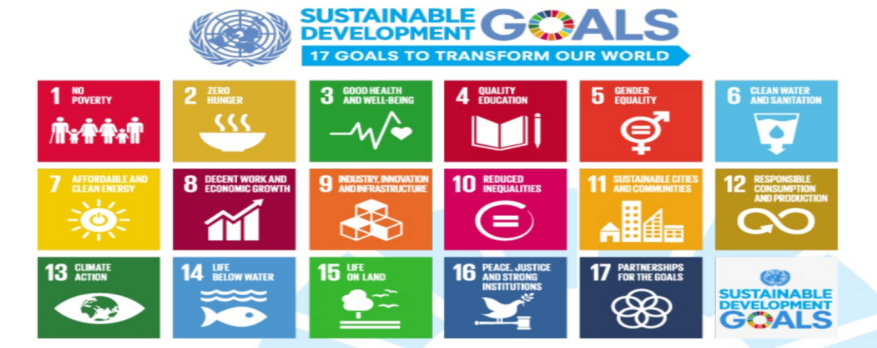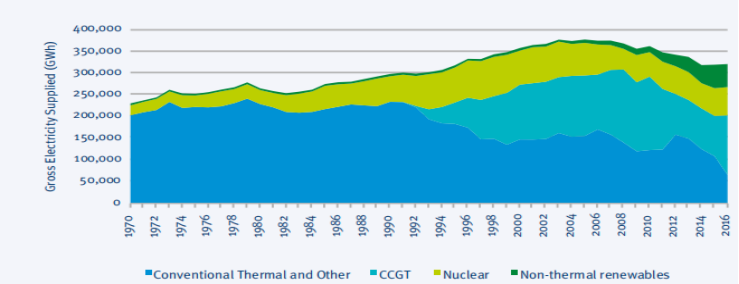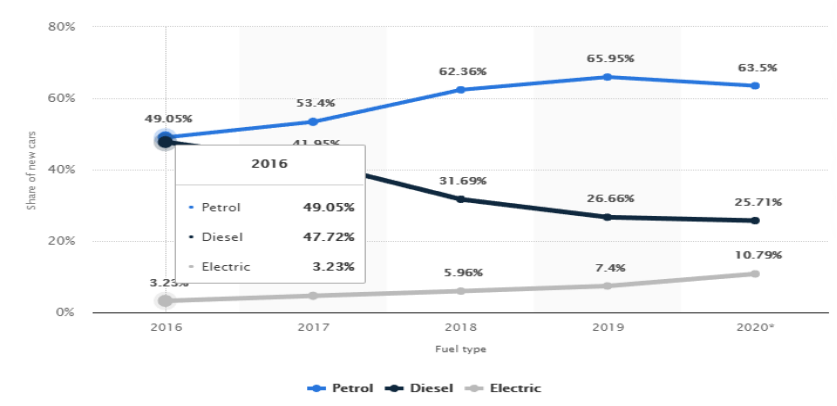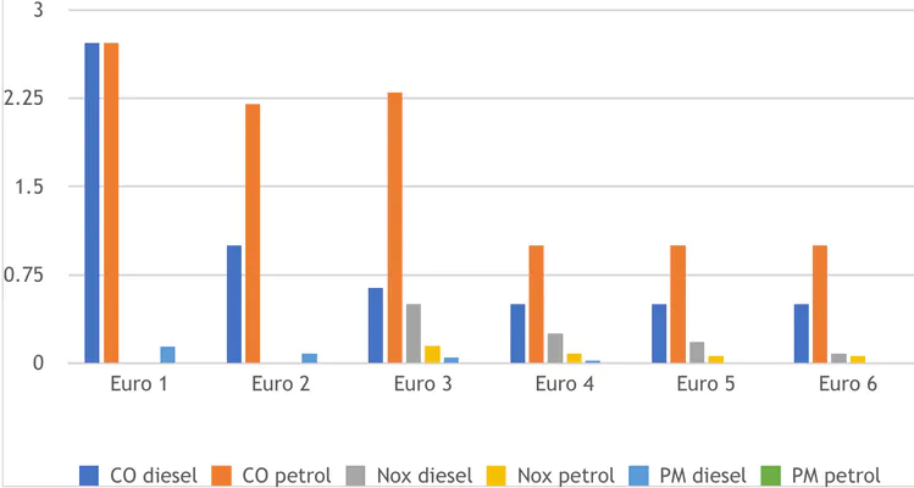1.0 Introduction
In this century, human beings are facing very severe environmental changes. Global warming, extreme weather condition, starvation and poverty, air pollution, etc, all threaten the existence of human species. Last year, Bushfires in Australia really shocked the world. The burned area is approximately to 18,636,000 hectares(Athukorala et al., 2019). The bushfire took away at least 34 people, destroyed over 6,000 buildings and burned countless trees. Many global experts and researchers point out that this natural disaster is mainly attributed to global warming and climate change. When the global average temperature keeps increasing, according to Sharples et al., (2016), global warming boosted the risk of hot and dry weather in Australia. Scientists also warn that if global temperature increases by another 20C, the risk of bushfires in Australia will be more frequent. In 2020, NASA reports that the bushfire in Australia at least another 306 million tonnes of carbon dioxide (Athukorala et al., 2019). It will further exacerbate the environmental problem of global warming. In fact, everyone of us are from a community of shared interest. Without promoting environmental sustainability, people in different parts of the world may suffer from these natural disasters and tragedies. The rise of global temperature will not only lead to bushfire (DeSisto, Cavanagh&Bartram, 2019). Coastal cities may be under the risk of being engulfed by the rise of sea level. One possible solution to fight against global warming is to reduce the carbon dioxide emission. Currently, it should be noticed that the major energy source is still fossil fuels. EPA reports that 76% of the U.S Greenhouse Gas (GHG) emission is attributed to the combustion of fossil fuels(Johnsson, Kjärstad&Rootzén, 2019). Besides, fossil fuels are also non-renewable and depleting at a rate much faster than the nature can replenish them. Therefore, it becomes very urgent to promote environmental sustainability and renewable energy types.
2.0 The Concept of Sustainability, Local and Global Challenges, Motivation of Change
By definition, sustainable development is referring to the development that meets the needs and demands of the present generation without compromising the ability of future generations. To be more specific, the development of current generation should not be at an expanse of the needs and demands of future generation. In 2015, the UNDP has stipulated 17 Sustainable Development Goals (SDGs) to address environmental, social and economic problems(Opoku, 2019). Climate action, for instance, is the 13th SDG. Both governments and private sectors should take the responsibility to reduce the emission of Greenhouse gases to fight against global warming.

Source Credit: UNDP
Fig 1: 17 Sustainable Development Goals (SDGs)
In fact, environmental sustainability is just one dimension of the concept of sustainability. The concept of sustainability represents the interaction of three pillars including environment, economy and society (Purvis, Mao &Robinson, 2019).
2.1 Three Pillars of Sustainability
First, environmental sustainability demands that social and human activities should not deteriorate, contaminate or destroy the life support systems of the world(Boussemart et al., 2020). For instance, in the wood logging industry, human beings are not stopped from harvesting woods to make furniture, artifacts, buildings, etc. But the harvesting rate should maintain the biomass and biodiversity in the forest. An unsustainable situation occurs when the deforestation process is faster than reforestation. The illustration of environmental sustainability can be viewed from Table 1 below, when the consumption of renewable resources is less than nature’s ability to replenish, the environmental sustainability goals can be achieved.
Table 1: Environmental Sustainability
Consumption of Natural Resources |
State of Environment |
Environmental sustainability |
Exceed Nature’s Ability to Replenish |
Environmental Degradation |
Unsustainable |
Equal to Nature’s Ability to Replenish |
Environmental Equilibrium |
Steady State Economy |
Less than Nature’s Ability to Replenish |
Environmental Renewable |
Sustainable |
Second, economic sustainability means that the unlimited economic development activities should be stopped(Anand &Sen, 2000). To a certain extent, economic development can improve people’s qualify of life and standard of living. But the unlimited exploitation of resources can exert negative impacts on natural environment. For instance, in the global automotive industry, many automobile producers including Toyota, Volkswagen, Tesla, etc, are working toward developing more environmental-friendly vehicle products. Now Tesla has gained a leading position in the global Electric vehicle market. Electricity as compared with gasoline, diesel and other types of fossil fuels will not generate carbon dioxide and toxic air pollutants. It is an example to show that how companies and organizations can work towards producing goods and services that satisfy customers’ demand and meanwhile reduce environmental harm.
Last, social responsibility is about identifying and managing both positive and negative impacts of systems, organizations, processes, etc, on local communities and the whole society(Dempsey et al., 2011). In the private sector, companies and organizations can work toward creating an equal, democratic, healthy and livable society. As a matter of fact, enterprises are an integral part of human society. Raw materials, energy, labor, land, and other critical resources are extracted from the society. In return, they should also bear social responsibility to support social capital and create social well-being. Toms Shoes, for instance, has implemented a corporate social responsibility (CSR) strategy to help the needy children. Its “One-for-One” strategy states that for every pair of shoes purchased, Toms will donate an identical pair to children from poor countries (Bachnik&Szumniak-Samolej, 2013). It shows that companies and organizations can make their own contribution to promote social equality in the society.
2.2 Local and Global Challenges regarding environmental sustainability
However, currently in the U.K, according to the reports from local think-tanks, the U.K should get anticipated for the potential shortage of electricity and “energy gap”. In other words, the country must have sufficient capacity to satisfy demand for foreseeable future. Fulli (2016) points out that electricity Security is very necessary and essential for a country to avoid the incidents of service disruptions, such as sudden rise in electricity price, shortage of electrical power, blackouts, etc. Originally, the U.K does not have very severe problem of electricity shortage. But like the aforementioned, the country is promised to reduce carbon dioxide emission and promote environmental sustainability. It is expected that electricity generated by power plant should be gradually replaced with other renewable and clean energy types such as hydro power, wind power, solar energy, etc. As shown in figure 2, it can be observed that from 1994 onward, the U.K starts to introduce clean energy to reduce the portion of electricity by conventional thermal energy (coals). But it is also indisputable that the electricity produced by conventional thermal energy or power plant is still very stable (Raugei, Hutchinson&Morrey, 2018). Solar energy, wind energy and many other renewable energy types have long been criticized for poor electricity conversion rate and efficiency. Thus, the potential local challenge is to fill the “energy gap” left by conventional thermal energy.

Source Credit: BEIS, 2016
Fig 2: Electricity Generated and Supplied from 1970 to 2015 in the U.K
On the other hand, global warming is certainly one of the most serious global challenge with respect to environmental sustainability. Like the aforementioned, in the past few decades, even though the United Nations are call for mutual efforts to reduce carbon dioxide emission, many industrial countries are still discharging excessive carbon dioxide and Greenhouse gases (GHGs) into the environment. The U.S was even withdrawn from the Paris Agreement. The reason behind is that the U.S wanted to save millions of jobs from heavy industries such as oil refinery industry(Dai et al., 2018). However, it should be noticed that the oil refinery process will generate a huge amount of carbon dioxide and exacerbate the environmental problem of global warming. China, India, and many other developing countries are also contributing to the emission of carbon dioxide. These countries insist that the emissions per capita should be used as the indicator to decide CO2 emission quota(Xu, &Song, 2010). But these claims cannot resolve the problem of climate change. Last year, the problem of global warming and extreme weather condition is the major cause of Australia’s Bushfire. By this token, the problem of global warming has now become a global challenge.
2.3 Motivation of Change
As a matter of fact, all countries are motivated to undertake environmental sustainability strategies. The U.K has a motivation to introduce more types of renewable energy to fully replace conventional thermal energy and fossil fuels in generating electricity. On one hand, it will address the problem of excessive CO2 emission. On the other hand, these strategies will promote electricity security for the country. Australia also has the motivation to address the problem of global warming. The country itself is a victim of global warming. The Bushfire last year destroyed thousands of trees and buildings in Australia. The life and property of average Australians are also threatened by the temperature change. Even China and the U.S should realize the importance of promoting environmental sustainability because the coastal cities of these countries may be engulfed due to the rise of sea level. In the private sectors, companies should bear the social responsibility to promote environmental conservation and sustainability. Enterprises rely on labor, land, electricity, and other production resources provided by the society. At the same time, they should also reciprocate by protecting well-being of key stakeholders in the society, such as local residents and communities.
There are two viable options for the U.K government to promote the development of electric vehicle market. First of all, the U.K government should sponsor the construction of EV charging infrastructure and facilities for the convenience of EV users. In China, for instance, local government heavily subsidizes the construction of “superchargers” for Tesla Drivers. It allows EV drivers to easily charge their vehicles at any time they want. It is very important because many potential customers of EV products are concerned about the availability of charging stations. If the facilities are not available, they will still stick to gasoline-powered vehicles despite the fact that they are not environmental friendly. Besides, the U.K government also has motivation to subsidize the consumption of EV products. For instance, taxes regarding the purchase of electric vehicles can be reduced or exempted. It will provide incentives for U.K customers to buy electric vehicles.
3.0 Determine how the automotive industry of the U.K could research zero carbon by 2050
The U.K Climate Change Committee makes recommendations to the U.K government to reach net zero carbon by 2050 (Bannon, 2019). The Committee points out that emission reduction policies should be strengthened. According to the statistics published by Statista (2020), hybrid electric vehicles (HEVs) and electric vehicles (EVs) only account for 10% of car registrations in the U.K in 2020. Most of the interviewed British consumers complain that it is very time-consuming for them to look for charging stands. So far, the availability of electric charging stations still cannot be compared with gas stations in the U.K. It is also the major reason why U.K consumers still prefer to purchase gas-powered vehicles. As shown in figure 3 below, even though the number of electric vehicles registration is increasing significantly in the past five years, ti should be noticed that the sales of patrol-powered vehicles is not declining. The total registration number of patrol-powered vehicles even increases from 49.05% in 2016 to 63.5% in 2020 (Statista, 2020).

Source credit: Statista, 2020
Fig 3: Private cars registration in the U.K from 2016 to 2020 by fuel type
3.1 Termination of Sales and Production of Patrol and Diesel vehicles
The U.K Climate Change Committee points out that if the automotive industry wants to reach zero carbon emission by the end of 2050, the U.K government must propose a fixed deadline of terminating patrol and diesel vehicle production and sales (Bannon, 2019).. The official advisory body of the Committee suggests that the sales of diesel-powered trucks should be stopped by 2040. Some researchers insist that the proposed deadline of 2040 might be too late. But it should be noticed that the EU has proposed a much late deadline. The termination of diesel-powered lorries is 2050 (Bannon, 2019).. But so far, the U.K government does not have a concrete plan and schedule to end the sales of diesel and patrol vehicles. According to the report of Varma et al., (2020), the combustion of diesel fuels is estimated to be 2.68 kg CO2/litre. The combustion of petrol is about 2.31 kg CO2/litre. Although the emission of CO2 patrol vehicles are slightly less than diesel engines, it is obvious that patrol and diesel vehicles emit the most amount of CO2 in the automotive industry.
But currently, the U.K government has not decided the deadline for ending diesel and patrol vehicles. It should be noticed that diesel vehicles, for instance, are not just emitting Greenhouse Gases (GHGs) but also toxic air pollutants such as Nitrogen Oxides. Nitrogen Oxides can lead to severe respiratory symptoms and adversely affect the health of U.K citizens. In addition, the fine particulate Matter (PM) created by the diesel engines can also lead to acute respiratory effects and even lung cancer (Giechaskiel et al., 2019). Before officially launching the “Brexit” policy, the U.K’s automotive market is also subject to the EU’s emission regulations. The PM emission limits in the European market can be illustrated in the figure 4 below. Through installing particulate filters, PM emission can be reduced by nearly 90%. But the problem is still not fully addressed. Hence, if the patrol and diesel vehicles can be terminated by 2040, not only carbon dioxide emission will be reduced to zero. Problems regarding toxic air pollutants will also be fully addressed.

Source Credit: Giechaskiel et al., 2019
Fig 4: EU Toxic Emission Limits in the Automotive Industry
3.2 Electric Vehicles in the U.K’s Automotive Market
Apart from terminating the production and sales of patrol and diesel vehicles, the U.K automotive industry should also target for 100% EV sales by 2040. Another ten year from 2040 to 2050 should be reserved for stabilizing the EV market and production in the U.K. Electricity is a clean energy that will neither generate GHGs nor toxic air pollutants. Theoretically speaking, the carbon footprint of electric vehicles is 0. According to the report published by Energuide, most electric vehicles will consume 15Kwh electricity per 100 km. As compared with gasoline or diesel vehicles, electric vehicles have an advantage of low energy loss. Petrol and diesel vehicles can only convert 35% of the energy into driving force. But electric vehicles can research 90% energy efficiency.
But currently, it should be noticed that HEV is still a popular choice for most U.K consumers (Bannon, 2019). Like the aforementioned, the availability of electricity charging stations is much lower than gas stations. In other words, even though consumers may be fully aware of the importance of environmental sustainability, they may still prefer HEVs to EVs simply because it is very time-consuming for them to charge their vehicle products. Another potential problem is that the electricity storage system of battery packs is far from being perfect. Most battery packs of electric vehicles cannot sustain a distant journey. But HEVs and patrol vehicles can perform well in a long journey. It is also the major reason why HEV and diesel lorries are still preferred in distant transportation. According to Bannon (2019), apart from electric vehicle technologies, hydrogen and battery heavy goods vehicles (HGVs) have already been successfully developed. Experts predict that HGVs will be commercially available this year. HGVs can be a potential alternatives to HEVs, pure EVs and diesel lorries in distant transportation by the end of 2040. Zero carbon emission can be fully achieved by 2050. So far, the freight sector accounts for 9% of the UK’s GHGs emission. Bannon (2019) points out that without further action, the emission of carbon dioxide could even increase by 20%. It will hinder the government’s effort to achieve zero carbon emission in the automotive industry.
However, besides terminating sales of patrol and diesel vehicles, and introducing electric vehicles, the U.K should also provide well-established infrastructure to boost EV sales. In China, for instance, governments from 14 major cities agree to construct a network of superchargers for Tesla drivers to charge their EV products(Gao et al., 2015). Through enhancing the availability of charging stands and stations, consumers will be more incentivized to purchase EV products.
4.0 How much area would be required for renewable energy to replace the primary energy demand for automotive industry
As shown in figure three, in the automotive industry alone, patrol and diesel are still the primary energy sources for transportation. If the U.K government targets for zero carbon or carbon neutral by 2050, renewable energy alternatives must be introduced into the picture. To a certain extent, electricity is a very clean energy source because it generates no carbon dioxide emission and toxic air pollutants. But as shown in figure 2, conventional thermal energy sources, mostly fossil fuels, are the primary energy source for generating electricity. Renewable energy such as nuclear energy, solar energy, wind energy, etc, have not yet replaced fossil fuels. As such, it shows that the introduction of electric vehicles does not fully address the problem of GHGs emission because fossil fuels like coals are used in power supply. In the past decade, the U.K government invests heavily in building nuclear plant to generate electricity. It now has 15 operational nuclear reactors including 14 AGRs and 1 PWR. The average cost of constructing a nuclear reactor is approximately $9 billion. Even though nuclear energy is clean and renewable, it should be noted that the nuclear reaction including nuclear fission and fusion are very dangerous and unstable. The Fukushima nuclear leakage, for instance, severely contaminate nearby water resources, led to genetic deformation of living creatures, and took away countless lives. It is also the major reason why many countries are planning to denuclearize by introducing other energy alternatives.
Solar energy, for instance, could be a viable option (Burnett,et al., 2014). In 2017, the solar panels in the U.K had generated about 12.8 GW of electricity, only representing 3.4% of the total electricity generation (Ma et al., 2018). By the end of 2018, nearly a million solar panels had been installed throughout the U.K. But the percentage of electricity generation is only increased to 3.9%. It shows that the U.K is currently lagging very much behind other developed countries. In Japan, for instance, the electricity generated by solar energy occupies nearly 10% of the total electricity generation. So far, Tesla is leading the world in terms of solar energy panels development. Tesla is not just famous for developing electric vehicle products but also owns advanced technology in terms of solar energy and energy-storage system. Tesla is not helping many cities in the world to launch its Solarcity projects. The concept of SolarCity is that residents are encouraged to install solar panels at home and generate electricity to cover the daily consumption(Mayfield&Siriwardane, 2018). Hence, the U.K government should work with private sectors like Tesla to promote the installation of solar panels in major cities of the country. Governments should also make investments in other energy supply sectors such as wind energy.
5.0 Conclusion
All in all, it is meaningful and essential for all countries in the world to work together toward promoting environmental sustainability. So far, global warming is undeniably one of the most serious environmental problems in the world. The extreme weather condition and high temperature are the root cause for Australia’s bushfires. The U.K also has an incentive to promote environmental sustainability because the discharge of CO2 and toxic air pollutants will also negatively influence the local environment. In the automotive industry, for instance, it is strongly recommendable for the U.K government to stipulate a clear schedule for ending sales or production of diesel and patrol vehicles. 100% electric vehicles should also be introduced into the market to replace patrol and diesel vehicles. Last, it is also recommendable for the U.K to promote clean energy alternatives like solar energy. By 2050, conventional thermal energy sources such as fossil fuels should be fully replaced by renewable energy types.
Reference
Athukorala, W., Martin, W., Wilson, C., & Rajapaksa, D. (2019). Valuing bushfire risk to homeowners: Hedonic property values study in Queensland, Australia. Economic Analysis and Policy, 63, 44-56.
Anand, S., & Sen, A. (2000). Human development and economic sustainability. World development, 28(12), 2029-2049.
Boussemart, J. P., Leleu, H., Shen, Z., & Valdmanis, V. (2020). Performance analysis for three pillars of sustainability. Journal of Productivity Analysis, 53(3), 305-320.
Bachnik, K., & Szumniak-Samolej, J. (2013). Shared value in practice: TOMS business model. Chinese Business Review, 12(9).
Bannon, E. (2019). UK government advisors call for net zero carbon by 2050 and ending fossil car and truck sales earlier. Transport & Environment. Accessed on 24th July 24, 2020. [Online]:https://www.transportenvironment.org/news/uk-government-advisors-call-net-zero-carbon-2050-and-ending-fossil-car-and-truck-sales-earlier
Burnett, D., Barbour, E., & Harrison, G. P. (2014). The UK solar energy resource and the impact of climate change. Renewable Energy, 71, 333-343.
DeSisto, M., Cavanagh, J., & Bartram, T. (2019). Bushfire investigations in Australia. Leadership & Organization Development Journal.
Dempsey, N., Bramley, G., Power, S., & Brown, C. (2011). The social dimension of sustainable development: Defining urban social sustainability. Sustainable development, 19(5), 289-300.
Dai, H., Xie, Y., Zhang, H., Yu, Z., & Wang, W. (2018). Effects of the US withdrawal from Paris Agreement on the carbon emission space and cost of China and India. Frontiers in Energy, 12(3), 362-375.
Fulli, G. (2016). Electricity Security: Models and methods for supporting the policy decision making in the European Union.
Giechaskiel, B., Joshi, A., Ntziachristos, L., & Dilara, P. (2019). European regulatory framework and particulate matter emissions of gasoline light-duty vehicles: A review. Catalysts, 9(7), 586.
Gao, P., Malorny, C., Sha, S., Guan, M., Wu, T., Luk, T.,& Xu, X. (2015). Supercharging the development of electric vehicles in China. McKinsey&Company. Available from internet: http://www. mckinseychina. com/wpcontent/uploads/2015/04/McKinsey-China_Electric
-Vehicle-Report_April-2015-EN. pdf.
Johnsson, F., Kjärstad, J., & Rootzén, J. (2019). The threat to climate change mitigation posed by the abundance of fossil fuels. Climate Policy